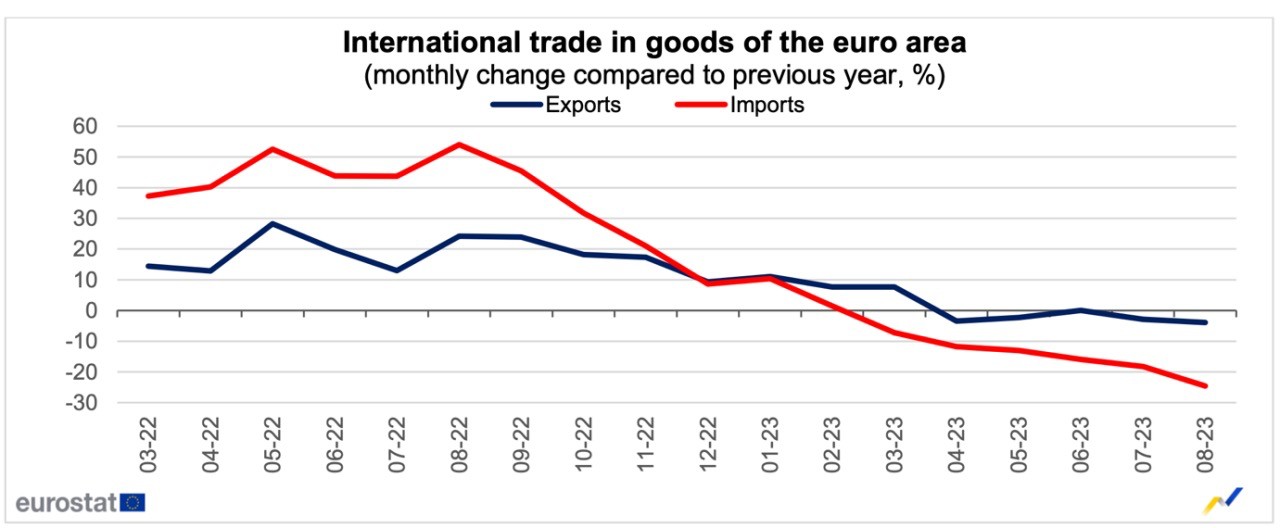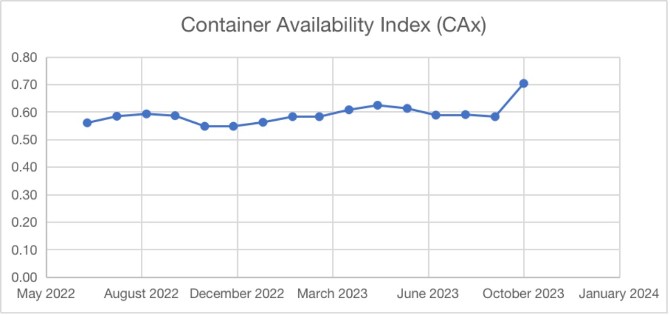31 October 2023, Hamburg, Germany: As the Euro Zone grapples with an ongoing economic crisis, facing declining trade and subsequently, a drop in container trade, the region struggles with the challenge of surplus containers causing repositioning costs exceeding the asset cost. Industry predicts that the container lessors are more focused on long term strategies so that the cost of repositioning may result extremely diluted over the asset lifetime.
Exactly one year prior, in November 2022, Container xChange reported the persistently deepening problem of an excess of containers burdening depots across Europe. Fast forward to today, and the situation has continued to escalate.
“We have a poisonous mix of severely imbalanced container trade with high level of excess inventory in Europe, and at the same time unreliable shipping services, suddenly lacking the vessel capacity to reposition empties out which in turn makes the situation even more difficult” commented Christian Roeloffs, cofounder and CEO, Container xChange an online container logistics platform based in Hamburg, Germany.
COVID aftermath in 2019, and later Russia’s war in Ukraine in 2022, left a permanent impact on EU’s trade with its major trading partners like China, the US, and UK. Subsequently, the imports and exports, both declined.

Retail trade volumes and economic sentiment, both further declined for the Euro Area in 2023. While the final household consumption further declined, the household savings grew from 14.5% in Q1 to 14.9% in Q2 2023.
With consumers retracting their expenditures persistently, and trade declining, this of course leaves its due impact on the shipping business in Europe.
Ports in Europe experience consistent month on month low import and export volume TEUs.
In the first nine months of 2023, there was 6% less throughput in the port of Rotterdam: 329.9 million tonnes compared to 351.0 million tonnes in the same period in 2022. The decline was mainly related to the throughput of containers and coal. The container segment saw a decline of 8.1% in weight and 7.2% in the number of containers (TEU, twenty feet equivalent unit) in the first nine months.
The import and export comparison are similar at the port of Antwerp and that of Hamburg.
The biggest struggle for container owners in Europe is the persistent problem of excess containers leading to overflowing depots. The container owners are looking for solutions to repatriate containers back to China and to Russia.
The excess of inbound containers this October is also evident in the Container availability Index (CAx) which measures the inbound and outbound containers at any given port. For Rotterdam, the values are at an all-time high at 0.70 this October as compared to 0.59 in October 2022. This indicates that the burden of containers is significantly higher in Rotterdam.

According to Drewry, In August 2023, the European Container Port Throughput Index saw a 0.4% MoM decline, reaching 100.2 points, down 2.8% dover the August 2022 level.
“Container owners are grappling with the issue of repositioning empty containers to Asia, and this task has become financially burdensome as repositioning costs now surpass the asset costs. However, the caveats here is that this could be an issue for operators looking for short term results, for instance, the traders. On the other hand, container lessors are more focused on long term strategies so that the cost of repositioning may result extremely diluted over the asset lifetime.” Commented Andrea Monti, Italian container depot owner Sogese chief executive Andrea Monti.
While the carriers are looking to reduce capacity in this region, on the other hand we see the persistent blank sailings trend. In the next five weeks, 9% of 660 scheduled sailings on major East-West routes are cancelled. Most of these cancellations (52%) are on the Asia-North Europe and Mediterranean routes, with 35% on Transpacific Eastbound, and 13% on Transatlantic Westbound routes.
“We do hear from our customers that depots are burdened, and the box owners are looking to move their containers to other regions. There is also a rush to reposition containers out of Russia and the prices there are quite low. With recessionary fears on the horizon in Europe, and specifically in Germany, the outlook for 2024 is shaky. But one thing is certain – 2024 will be better than 2023 for the container shipping industry.” Shared Christian Reoloffs, cofounder and CEO of Container xChange.
The biggest uncertainty is the geopolitical risks that have been destructive for the supply chain industry.
“The Israel – Palestine conflict have remained a regionally destructive humanitarian crisis and have not yet impacted the European Union's trade and economy. Nevertheless, it is essential to recognize that the container market is highly sensitive to broader economic and geopolitical shifts, as these can substantially influence global trade. The ongoing conflict in Israel holds the potential to affect consumer confidence, manufacturing operations in the region, and ultimately trade volumes emanating from that area.” Roeloffs added.
Amidst this, there are positive signs for container trade witnessed on the Container xChange platform. Russia is a very popular container trading and leasing market.
“Hot stretches include 40 ft high cubes from Ex Russia to China and Intra Russia. The container prices are more stable now in Euro area and in China which brings cheer for box trading players as more stable prices gives way to plan the moves better.” Jakob Hafner, Business Unit Leasing & Trading, Germany, Container xChange.
An overview of the container prices across key ports in Europe
Average prices for 40 ft high cube cargo worthy containers down by 44% this year in October 2023 from October 2022 across key ports in Europe, lowest in four years since 2020.
Similar trend is observed for 20 ft DC, cargo worthy containers. However the decline is steeper for 40 ft HC containers, as compared to 20 ft DCs across ports in Europe.
Container xChange periodically deep dives into the container trading and leasing market trends to help equip its customers and industry drive better container business decision making. This analysis evaluates company and market information to contextualise solid understanding of the macro economic factors and draws correlation into how these are impacting the container market in the region.
The opinions expressed herein are the author's and not necessarily those of The Xinde Marine News.
Please Contact Us at:
media@xindemarine.com



 Ningbo Containerized Freight Index Weekly Commentar
Ningbo Containerized Freight Index Weekly Commentar  Ningbo Containerized Freight Index Weekly Commentar
Ningbo Containerized Freight Index Weekly Commentar  Ningbo Containerized Freight Index Weekly Commentar
Ningbo Containerized Freight Index Weekly Commentar  BIMCO Shipping Number of the Week: Bulker newbuildi
BIMCO Shipping Number of the Week: Bulker newbuildi  Ningbo Containerized Freight Index Weekly Commentar
Ningbo Containerized Freight Index Weekly Commentar  Ningbo Containerized Freight Index Weekly Commentar
Ningbo Containerized Freight Index Weekly Commentar